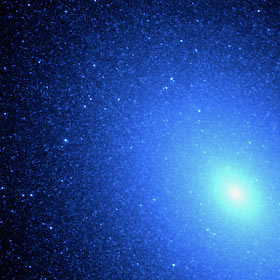
Enregistrez gratuitement cette image
en 800 pixels pour usage maquette
(click droit, Enregistrer l'image sous...)
|
|
Réf : S02587
Thème :
Galaxies (118 images)
Titre : Utraviolet Light Source in an Old Galaxy
Description : (La description de cette image n'existe qu'en anglais)
Hubble Space Telescope's exquisite resolution has allowed astronomers to resolve, for the first time, hot blue stars deep inside an elliptical galaxy. The swarm of nearly 8,000 blue stars resembles a blizzard of snowflakes near the core (lower right) of the neighboring galaxy M32, located 2.5 million light-years away in the constellation Andromeda. Hubble confirms that the ultraviolet light comes from a population of extremely hot helium-burning stars at a late stage in their lives. Unlike the Sun, which burns hydrogen into helium, these old stars exhausted their central hydrogen long ago, and now burn helium into heavier elements. The observations, taken in October 1998, were made with the camera mode of the Space Telescope Imaging Spectrograph (STIS) in ultraviolet light. The STIS field of view is only a small portion of the entire galaxy, which is 20 times wider on the sky. For reference, the full moon is 70 times wider than the STIS field-of-view. Thirty years ago, the first ultraviolet observations of elliptical galaxies showed that they were surprisingly bright when viewed in ultraviolet light. Before those pioneering UV observations, old groups of stars were assumed to be relatively cool and thus extremely faint in the ultraviolet. Over the years since the initial discovery of this unexpected ultraviolet light, indirect evidence has accumulated that it originates in a population of old, but hot, helium-burning stars. Now Hubble provides the first direct visual evidence.
|
|

